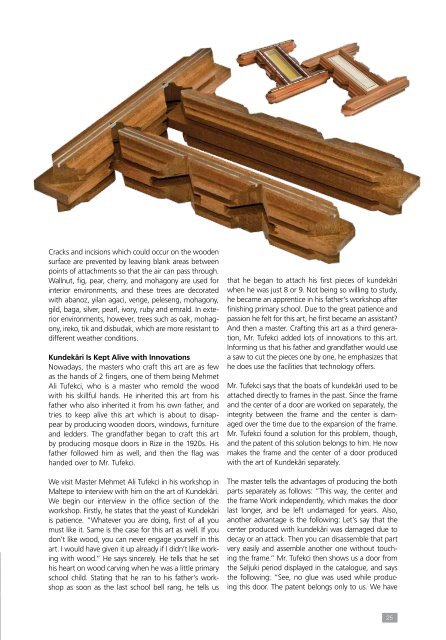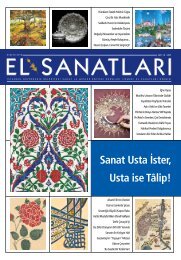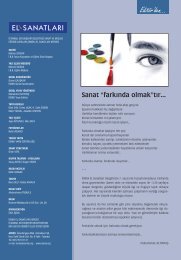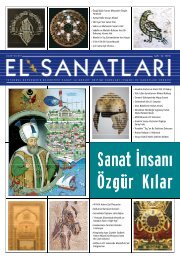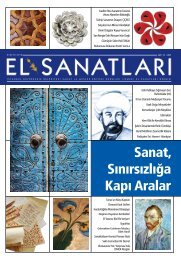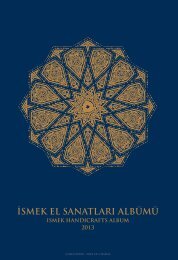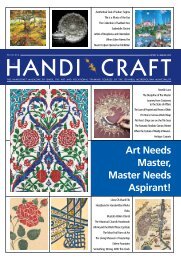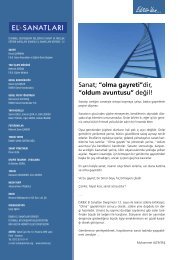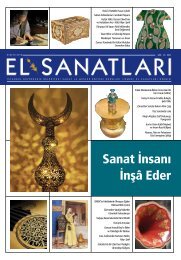A tiny seed which carries inside it a long life first becomesa very thin young plant, and later turns into a young tree.Over the years, it becomes a strong, huge and a wisetree which shades those who rest under its branches.Later, it slowly gets old, but still does not give up life totallysince another adventure begins for it even if it is cutdown. We always run into it again and again in differentforms, in different fields of life. It sometimes becomes adoor which opens ahead of us, a handrailing we hold on,or an elegant cupboard which hides our belongings. Nomatter which forms it takes in the skillful hands of themasters, though, it certainly makes the environment welive or work lovelier, more friendly and more colorful asopposed to the cold atmosphere concrete causes.Original Works of Art in Kundekâri Comesout of Turkish Masters’ HandsWood carving has an important status in our traditionalhandicrafts. Used fairly frequently by the preislamic civilisationswhich settled in the Central Asia, wood wascarved to produce many things used in the daily life,such as saddles, harnesses and chests. Only few worksof art have survived up to our day from those civilisationsdue to their lack of resistance against time, yetnumerous examples which show us the progress of theart in Anatolia give us detailed information regardingour wood carving history.Wood carved works created during the Seljukis weremostly architectural elements such as mosque doors,alters, or cupboard doors which showed the best examplesof a superior quality workmanship. During theOttoman civilisation where simplicity was more dominant,however, we see that the variety of things producedwith this art increased greatly, and the use ofwood had a wider range. tables, drawers, cupboarddoors, quilted turbans, writing utensils, beams, consoles,column heads, altars and sarcophaguses arethose that firstly come to mind.Wood carving which advanced greatly during the GreatSeljuki civilisation progressed until the art of kundekâri,which requires knowledge on geometry, to be born. Architecturalelements such as mosque doors and altarswhich were produced with the art of kundekâri, whereno elements of attachment such as nails are used, andwhere pieces are designed in a way that they can be fastenedto one another, were also protected by the statein order for them to last longer. Though this art is craftedboth in Iran and in Arabia, it will not be an exaggerationif we say that the most beautiful works of art producedwith this art have always been in our territories.Pearl and Ivory: The Ornament of KundekâriIn kundekâri which is crafted by attaching pieceswhose edges are carved in the negative and positive,or male and female way, cut in polygon or starshapes, and ornamented with Anatolian or palmetstyle relieves, to one another with wooden beams,the decorative composition is based on a geometricscheme. Star which symbolizes eternity is usedalong with many geometric arangements such asoctagon or baklava. The composition is mademore colorful by placing little wooden plates ofdifferent colors or shapes in between. Also,carving, ivory inlaying and baga which areseen in some compositions in addition toespecially pearl and ivory makes the compositiona holistic one.Since pieces are not attached to one anotherwith any elements of attachment such asnail or glue, the wooden surface where theart of kundekâri has been applied remainswhole. In some of the works of art producedwith kundekâri, a wooden skeleton is placedbehind the points of attachment to make thework last longer. Special attention is paid to optfor the tree which best resists against differentseasons and weather conditions.24
Cracks and incisions which could occur on the woodensurface are prevented by leaving blank areas betweenpoints of attachments so that the air can pass through.Wallnut, fig, pear, cherry, and mohagony are used forinterior environments, and these trees are decoratedwith abanoz, yilan agaci, venge, peleseng, mohagony,gild, baga, silver, pearl, ivory, ruby and emrald. In exteriorenvironments, however, trees such as oak, mohagony,ireko, tik and disbudak, which are more resistant todifferent weather conditions.Kundekâri Is Kept Alive with InnovationsNowadays, the masters who craft this art are as fewas the hands of 2 fingers, one of them being MehmetAli Tufekci, who is a master who remold the woodwith his skillful hands. He inherited this art from hisfather who also inherited it from his own father, andtries to keep alive this art which is about to disappearby producing wooden doors, windows, furnitureand ledders. The grandfather began to craft this artby producing mosque doors in Rize in the 1920s. Hisfather followed him as well, and then the flag washanded over to Mr. Tufekci.We visit Master Mehmet Ali Tufekci in his workshop inMaltepe to interview with him on the art of Kundekâri.We begin our interview in the office section of theworkshop. Firstly, he states that the yeast of Kundekâriis patience. “Whatever you are doing, first of all youmust like it. Same is the case for this art as well. If youdon’t like wood, you can never engage yourself in thisart. I would have given it up already if I didn’t like workingwith wood.” He says sincerely. He tells that he sethis heart on wood carving when he was a little primaryschool child. Stating that he ran to his father’s workshopas soon as the last school bell rang, he tells usthat he began to attach his first pieces of kundekâriwhen he was just 8 or 9. Not being so willing to study,he became an apprentice in his father’s workshop afterfinishing primary school. Due to the great patience andpassion he felt for this art, he first became an assistant?And then a master. Crafting this art as a third generation,Mr. Tufekci added lots of innovations to this art.Informing us that his father and grandfather would usea saw to cut the pieces one by one, he emphasizes thathe does use the facilities that technology offers.Mr. Tufekci says that the boats of kundekâri used to beattached directly to frames in the past. Since the frameand the center of a door are worked on separately, theintegrity between the frame and the center is damagedover the time due to the expansion of the frame.Mr. Tufekci found a solution for this problem, though,and the patent of this solution belongs to him. He nowmakes the frame and the center of a door producedwith the art of Kundekâri separately.The master tells the advantages of producing the bothparts separately as follows: “This way, the center andthe frame Work independently, which makes the doorlast longer, and be left undamaged for years. Also,another advantage is the following: Let’s say that thecenter produced with kundekâri was damaged due todecay or an attack. Then you can disassemble that partvery easily and assemble another one without touchingthe frame.” Mr. Tufekci then shows us a door fromthe Seljuki period displayed in the catalogue, and saysthe following: “See, no glue was used while producingthis door. The patent belongs only to us. We have25
- Page 1: Art Leads Oneto Eternity!
- Page 4 and 5: In ThisEdition1506The StringentMast
- Page 6: Dear Istanbulians,After the industr
- Page 10 and 11: One Marbler Has Carried This Colorf
- Page 12 and 13: this art”. Being single those day
- Page 14 and 15: in flower marbling.” He says, and
- Page 16 and 17: Cicek Derman: The DoyenneFlower of
- Page 18 and 19: and does not want her to either stu
- Page 20 and 21: der the very inside of you.” She
- Page 22 and 23: ate” at all. The creator is one,
- Page 25: Kundekâri:The Time Defying Heritag
- Page 30 and 31: land to understand weather he can p
- Page 32 and 33: When Deep WavesWash Ashore!by A. Ul
- Page 34 and 35: 'Bismillah' by Omer Faruk Deretaste
- Page 36 and 37: 'The Asr Surah' by Mustafa Cemil Ef
- Page 38 and 39: Van Gogh,The Genious Painter of Yel
- Page 40 and 41: and anxieties that surrounded him s
- Page 42 and 43: The most prominent features which w
- Page 44 and 45: Starry Night Over the Rhonehe opted
- Page 46 and 47: the left side of his face is a colo
- Page 48 and 49: The Threaded Version of Silver isRe
- Page 50 and 51: out from a narrower hole. Theseoper
- Page 52 and 53: Sumi-e: The Elegance which Comesint
- Page 54 and 55: traditions, perform this art seated
- Page 56 and 57: sumed in half an hour after it is p
- Page 59 and 60: er in ISMEK, after her illumination
- Page 61 and 62: 59Illustration: Hatice Ozturk
- Page 63 and 64: there was a captures chamberlain. 5
- Page 65 and 66: lack sides. As far as I can see del
- Page 67 and 68: One of the founders of the civilisa
- Page 69 and 70: The miniature by Ochiai Yoshiiku da
- Page 71 and 72: Miniatures are in the Irony of West
- Page 73 and 74: pictions of various countries, coul
- Page 75 and 76: A miniature example from the work n
- Page 77 and 78:
“Ve mâ rameyte iz rameyte ve lak
- Page 79 and 80:
usually there is a part consisting
- Page 81 and 82:
When applied on wood, Edirnekâri c
- Page 83 and 84:
What is very distinct regardingthe
- Page 85 and 86:
The ceiling decorations, corner cab
- Page 87 and 88:
There is an epigram for the Artof C
- Page 89 and 90:
If the paper had spoken and told wh
- Page 91 and 92:
nailing, gluing or compressing of t
- Page 93 and 94:
gold. The notebooks with gold leave
- Page 95 and 96:
laminary and get the required thick
- Page 97 and 98:
Both the insufficience of green fie
- Page 100 and 101:
15 years ago, Mr. Yesilce allocated
- Page 102 and 103:
On the Zoomorphic1Originsof the Rum
- Page 104 and 105:
Shape-6Shape-13another finding foun
- Page 106 and 107:
The Harem in the Topkapi Palace,The
- Page 108 and 109:
very much like the school of boys i
- Page 110 and 111:
The Blue Doors of TunisiaThe Articl
- Page 112 and 113:
Tunisia is the pearl of the Mediter
- Page 114 and 115:
Ottoman CultureProducts from Qadi R
- Page 116 and 117:
An Overview of Written Sourcesin Ot
- Page 118 and 119:
Signature of Abdulhamit II on the c
- Page 120 and 121:
Pieces of Wastepapers TurnInto Jewe
- Page 122 and 123:
in a short time, we ask him to make
- Page 124 and 125:
Symbols of theLife of Thoughtby Pro
- Page 126 and 127:
The Gulpayegan Masjid Kufi writing
- Page 128 and 129:
which show some of the monumental w
- Page 130 and 131:
An appearance from the interior of
- Page 132 and 133:
The Kufic script at the top is prep
- Page 134 and 135:
in yerinize grafologla konusuverir.
- Page 136 and 137:
considered as a hard science rather
- Page 138 and 139:
Zeynep Bornovali states that differ
- Page 140 and 141:
The Dance of the Needle with Cerami
- Page 142 and 143:
was not the case, however, for the
- Page 144 and 145:
an area determined on the material
- Page 146 and 147:
Dilek Hanif: A Fashion DesignerWho
- Page 148 and 149:
others prefer to have a single and
- Page 150 and 151:
Princess Nazli:The Patron of Arts a
- Page 152 and 153:
which was also known as “Villa He
- Page 154 and 155:
A Bouquet From the Hidden Paradiseb
- Page 156 and 157:
Canfeza (Heart touching) A fully st
- Page 158 and 159:
“Someone whom I hadn’t met befo
- Page 160 and 161:
The Storm of ISMEK Blowingin the In
- Page 162:
Menaf Nam's work which was awarded


